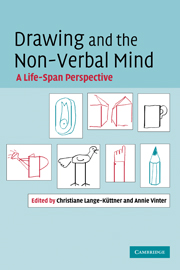Book contents
- Frontmatter
- Contents
- Contributors
- 1 Contemporary enquiries into a long-standing domain: Drawing research
- Part I Self, symbols and intention
- Part 2 Syntax, space systems and projection
- 7 The interaction of biomechanical and cognitive constraints in the production of children's drawing
- 8 Graphic syntax and representational development
- 9 Spatial structures in children's drawings: how do they develop?
- 10 Figures in and out of context: absent, simple, complex and halved spatial fields
- 11 Spatial and symbolic codes in the development of three-dimensional graphic representation
- 12 On contours seen and contours drawn
- Part III Aging, blindness and autism
- Index
- References
10 - Figures in and out of context: absent, simple, complex and halved spatial fields
Published online by Cambridge University Press: 22 September 2009
- Frontmatter
- Contents
- Contributors
- 1 Contemporary enquiries into a long-standing domain: Drawing research
- Part I Self, symbols and intention
- Part 2 Syntax, space systems and projection
- 7 The interaction of biomechanical and cognitive constraints in the production of children's drawing
- 8 Graphic syntax and representational development
- 9 Spatial structures in children's drawings: how do they develop?
- 10 Figures in and out of context: absent, simple, complex and halved spatial fields
- 11 Spatial and symbolic codes in the development of three-dimensional graphic representation
- 12 On contours seen and contours drawn
- Part III Aging, blindness and autism
- Index
- References
Summary
As in Lewin's theory of the interaction between field forces and figures in real life, Lange-Küttner explains that similar interactions occur between figures and spatial fields in pictorial space. Young children initially draw just figures in empty space with only implicit spatial relations, but gradually the spatial context becomes explicit and elaborated in an increasingly complex fashion. She thus assumes an initial object-based figure representation, which later changes into a space-based figure representation. This is illustrated by a comparison between figure drawings of young children and visual neglect patients. Lange-Küttner demonstrates empirically that figure size in children's drawings is increasingly determined by powerful pictorial rules rather than by environmental experiential factors. Her experimental studies show an emerging, systematic contingency between figure size and complexity of the spatial field, with sensitivity to spatial constraints as transitional mechanism between object-based and space-based figure representation. From an evolutionary perspective, axes systems are geometrically not more complex than spiderwebs, but while spiders continued to devour the objects caught in the net, the specifically human achievement appears to be the object permanence and apparent animation of the figures in the axes systems.
the spatial field was one of the central concepts of Lewin (1951, 1963/1982), where superior forces were impacting on figures, which could evade them by leaving the field, find ways around boundaries and barriers in order to reach a goal, or cope with field forces by overcoming pressure and frustration.
- Type
- Chapter
- Information
- Drawing and the Non-Verbal MindA Life-Span Perspective, pp. 195 - 216Publisher: Cambridge University PressPrint publication year: 2008
References
- 7
- Cited by



